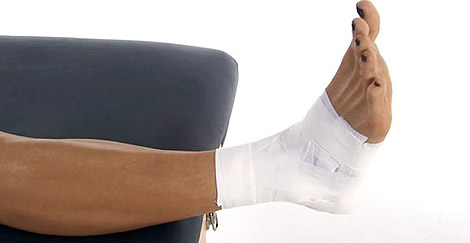Home > Conditions Treated > Ligament Injuries or Sprains
STAGE 1
The fibers of the ligament are stretched but intact
STAGE 2
Is a partial tear of a ligament
STAGE 3
Is a complete rupture of the ligament, sometimes avulsing a piece of bone
Symptoms of sprains include: pain, swelling, bruising, decreased ability to move the limb, difficulty using the affected extremity. Typically, with Grade I sprains, symptoms are short lived, lasting 1-2 weeks with recovery often being complete with limited long-term effects. Weightbearing is usually seen within days with Grade I sprains, whereas pain often limits weight bearing in grade II & III sprains.
Symptoms with Grade II & III sprains may last much longer, often several months. Patients will often report hearing or feeling a pop with grade II & III sprains and joint instability may follow due to a resulting longer ligament (i.e. the bones are not bound together as tightly). In this case, there may be greater unintended motion at the affected joint.
Initial management of a sprain may involve: Protection with a brace, Compressive wraps along with R.I.C.E. (i.e. Rest, Ice, Compression, Elevation). More recent recommendations have included mobilization within 1-3 days following injury (if possible), heat (x 10 min) followed by ice (x 5 min) and acetaminophen to minimize the effect to the inflammatory process that helps to heal the ligament.

A diagnosis of a sprain can often be made with a good degree of certainty by physical examination based on the clinical presentation and method of injury. In some cases, X-rays are obtained to ensure that there is no fracture.
Displacement of normal joint architecture in a joint can be an initial indication that a ligament has been torn. In some cases, particularly if the injury is prolonged or does not appear to be resolving as expected, an magnetic resonance imaging (MRI) is performed to look at surrounding soft tissues and the ligament (X-Ray will not show soft tissue thus making it difficult to assess the extent of injury to a ligament). MRI may also help to rule out Osteochondritis Dessicans (i.e. cartilage injury) within the joint.
Moving the limb soon after a sprain has been shown to promote healing by stimulating growth factors in musculoskeletal tissues linked to cellular multiplication and matrix remodeling. The components of an effective rehabilitation program for all sprain injuries include increasing range of motion and progressive muscle strengthening exercise. Usually this is best accomplished with the assistance of a physical therapist or chiropractor. Prolonged immobilization delays the healing of a sprain, as it usually leads to muscle atrophy and weakness.
Orthobiologic Treatments such as Platelet Rich Plasma (PRP) or Bone Marrow Aspirate are effective in healing micro or partial tears (Grade I & II injury). The aim of using orthbiologic cellular medicine is to support your body’s self-healing processes, reverse disease progression and suppress inflammatory reactions that can worsen pain, leading to symptom relief and recovery of function. We utilize regenerative medicine procedures including patients’ own cells to repair the ligaments naturally.
As part of a cell-based treatment, regenerative cells can be collected from bone marrow and blood with minimal discomfort. These cells can then be processed in a state-of-the-art laboratory utilizing the latest technology. Finally, the regenerative cells, in combination with natural growth and healing factors, can be injected where they are needed – such as an inflamed hip or knee joint. Over time, the cells can potentially repair and regenerate the damaged tissues, resulting in relief of pain and improvement in mobility and function.
Grade III sprains (or complete ligament ruptures) generally require surgery for end to end repair of the ligament and relocation of the bones of a dislocated joint. Sometimes associated fractures are repaired at the same time.
Although Orthobiologic Cell Therapy is considered by some people to be experimental, various research studies show that some marrow aspirate concentrate and platelet rich plasma injections may provide excellent relief from joint and musculoskeletal pain and ongoing inflammation.
600 Worcester Rd, Ste 301,
Framingham, MA 01702
This information is for educational purposes only and is NOT intended to replace the care or advice given by your physician. Always seek the advice of your physician or other qualified health provider before starting any new treatment or with any questions you may have regarding a medical condition. For more information see our Medical Disclaimer.